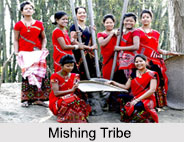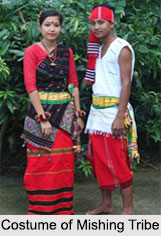 Mishing Tribes are also called "Miri" by the local people. They are mainly concentrated in nine districts of Assam - Tinsukia, Dibrugarh, Sibsagar, Jorhat, Golaghat, Darrang, Sonitpur, North-Lakhimpur and Dhemaji. They live in villages preferably on the bank of rivers in pile houses and can be easily distinguished by their dresses.
Mishing Tribes are also called "Miri" by the local people. They are mainly concentrated in nine districts of Assam - Tinsukia, Dibrugarh, Sibsagar, Jorhat, Golaghat, Darrang, Sonitpur, North-Lakhimpur and Dhemaji. They live in villages preferably on the bank of rivers in pile houses and can be easily distinguished by their dresses.
Origin of Mishing Tribes
Mishing Tribes belong to Mongoloid group of people. Linguistically they belong to Tibeto-Burman sub-family. They also speak in Assamese language. In this sense the Mishings are bilingual people. They have settled along the south western belt bordering the state of Assam.
Society of Mishing Tribes
Mishing Tribes are distributed in villages of Paglam circle and are similar in many ways to Adi tribe of Arunachal Pradesh. The Mishing consists of several loosely-knitted groups and each group consists of several clans of close blood relation. Every clan bears a particular title of surname. They practice clan-exogamy. Monogamy is the common form of marriage though polygamy is found among them. The Mishings are patriarchal and descent is in the male or father`s line. The sons inherit the family property. Cross-cousin marriage is prevalent among the Mishings. "Midang" and "Dugla-lanam" are the common forms of marriage among them.
Occupation of Mishing Tribes
Mishing people are dependent on agriculture for earning livelihood. They practice permanent cultivation though shifting cultivation has not been fully given up. The crops that are mainly grown by them are pulses, paddy, maize and mustard and varieties of vegetables. They also cultivate different varieties of rice. They are also considered as expert fishermen. Fishing is another occupation of the Mishing people. The women of the community also contribute to the family income by rearing pigs, fowls and goats.
They also cultivate different varieties of rice. They are also considered as expert fishermen. Fishing is another occupation of the Mishing people. The women of the community also contribute to the family income by rearing pigs, fowls and goats.
Religion of Mishing Tribes
The Mishing are originally animistic due to the influence of Shri Shankaradeva- the preacher and devotee of Vaishnavism in Assam. However, it has been highly influenced by the culture of Hindu religion. Some sections of the Mishing tribe have adopted Hinduism, while the others retain the indistinct religious notions of their ancestor believing in the existence of numerous malevolent and benevolent deities. Mishing people believe in the existence of supernatural beings.
Festivals of Mishing Tribes
"Ali-Aye-Ligang" and "Porag" are important festivals of the Mishing. These festivals are celebrated by special dance by boys and girls. Both these festivals are associated with cultivation. Ali-Aye-Ligang is celebrated during the month of February. They offer prayers for obtaining the blessings of the almighty for abundant crop. Porag festival is considered as a post harvest festival. It is a grand three days festival of the Mishing tribe. During the celebration of these festivals, they organise hunting expeditions and arrange grand feasts.
Culture of Mishing Tribe
There are several dances and festivals of the Mishing tribe. Their dances are called Paksong or Soman and it bear great similarity with the Bihu dance of Assam. Their songs also known as Niton are chiefly of three major types and these are Aku, Oi and Anu Nitone. Aku basically contains history and rich culture of the people whereas Oi and Anu Nitone are contemporary love songs and use modern musical instruments. Drum, clapping metal bells and bansuri are the local instruments used by Mishing tribe.
Costumes of Mishing Tribes
The costumes of Mishing tribe are interesting. Male dresses are almost alike the Assamese with white dhoti as the lower garment, a white bush shirt or Kurta as the upper garment and with a turban on the head. However, these people differentiate themselves by wearing a cover coat with parallel and stripe design known as "Mibu Galuk". On the other hand, females of this tribal group wear a self-woven cloth, which is known as "Gaseng", as the lower garment retaining it on the waist and "Kebbung" as the upper garment that is covered round just below the shoulders.
















